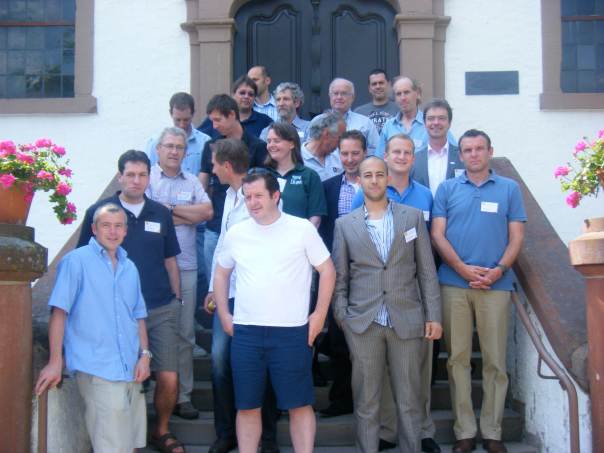
Today is the final day of the Computer Science in Sport Conference (Special Emphasis:Football) at Schloss Dagstuhl. The morning session discussed Media and Data Acquisition issues. The session was chaired by Daniel Link (TU Munchen).
Daniel presented first in this session. He reported on the Game Data Library Project for the Bundesliga.
The aims of the Project are:
- Technical: better data validation and better IT infrastructure
- Commercial
Daniel discussed the game observation process for the Game Data Library. This involves the acquisition of basic data that includes match information data, tracking data (at 25hz), event data, static video data that are used to create raw data and statistics. Daniel presented the architecture of this service to provide data flow.
He discussed the Game Data Model. Daniel presented an ontology of definitions in use in this project. This ontology has a data structure for: smart calculation; efficient processing and storing of data; and object orientation and the use of Unified Modelling Language (UML).
Daniel concluded his talk with a consideration of the challenges of this project for sport science. These included how to use the enormous amounts of data that will be generated and how to develop tools to analyse the data.
 Roland Leser (Universitat Wien) was the second presenter in the session.
Roland Leser (Universitat Wien) was the second presenter in the session.
His topic was Position tracking as a challenge in game sport analysis. Roland’s abstract:
About 10 to 15 years ago only top level teams used computer assisted video annotation systems to analyze sport games and training sessions. The progress in hardware and software development made it happen that nowadays this technique is used even at amateur level. Pointing to another analysis technique we have at present similar conditions than in the situation described above. Very expensive video based position tracking systems are used by few of the top teams worldwide to analyze their game play and GPS-systems are applied to analyze training sessions of outdoor sports. Radio wave based tracking systems are currently not wide spread for performance analysis but they could dominate the future. By tendency radio wave sensors become smaller and cheaper in the next years and radio wave based tracking systems are much less service intensive than other systems. Looking forward, this kind of tracking system could be a worthwhile alternative to analyze games and training sessions of game sports for many teams. This presentation gives an overlook on the preparatory work of installing an industrial radio wave based tracking system (www.ubisense.net) for game sports analyses, outlines current results and looks ahead to future works.
In his talk Roland gave an excellent exposition of how to develop a position tracking system.
He noted systems such as Tracab and Catapult. He discussed radio wave systems too, including Ubisense (tag) and InMotio LPM (transponder).
In choosing a system for use in his research Roland identified these criteria:
Off the shelf availability of a system:
- Price
- Sensor size
- Sampling rate
- Accuracy
- Robustness (hardware, signal, definition of player)
- Application in training and game play
- Opponent agreement within competition
Roland discussed the use of an Ubisense system. To date this system has not been used extensively in sport. He demonstrated the installation of the system in a sports hall. Ubisense has a 160hz facility that is not common with other Ubisense clients. The hall is calibrated and then checked for accuracy of measurement. The system allows some for data filtering (low pass and Kalman). Roland noted the development of software tools for the system to enable data visualisation (including heat maps) and performance analysis.
Roland shared an example of the recording movement with the system (small sided football).
 The final presentation of the morning was by Malte Siegle. Malte looked at the accuracy of image recognition in dynamic situations. He shared the development of protocols to check the accuracy of image recognition in respect of Laveg and laser light measurement.
The final presentation of the morning was by Malte Siegle. Malte looked at the accuracy of image recognition in dynamic situations. He shared the development of protocols to check the accuracy of image recognition in respect of Laveg and laser light measurement.
The field tests were conducted in a soccer stadium:
1. A linear run near the cameras with constant velocity. (Image detection worked well.)
2. Acceleration, stop, reacceleration in same direction. (Image detection issues arise with up to 1 metre error.)
3. Two players move towards each other and return after 180 degrees turn. (An error of more than 1.5 metres.)
4. Circular run with constant velocity (Image detection worked well.)
Malte noted the variability in errors in these tests and discussed the impact of the player’s distance from the cameras.
Theses tests had identified the need for better static position detection and the clear differentiation of error sources (distractions). Malte did end with some very positive views about the protocols: good values were recorded and problems were identified. This research raised the possibilities of a new standard in the evaluation of image detection. Ultimately this will lead to the comparisons of different image detection systems.
The final session of the day was chaired by Martin Lames. This was an informal review and evaluation of the Conference. Everyone agreed that the Dagstuhl experience was outstanding and all participants hoped to have the privilege of returning.






